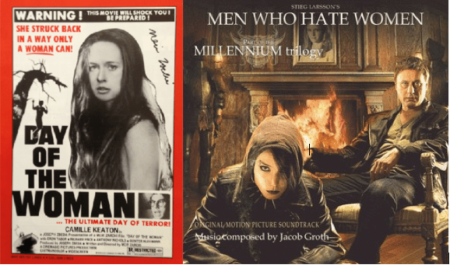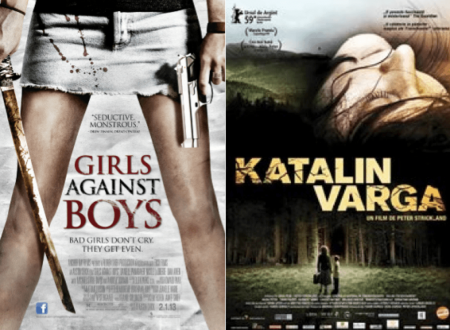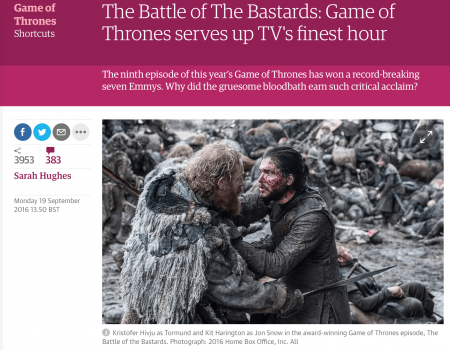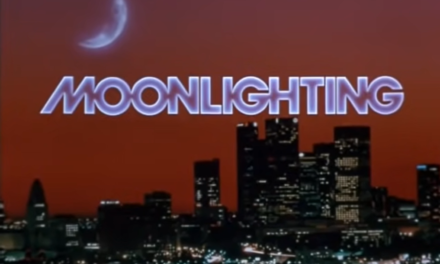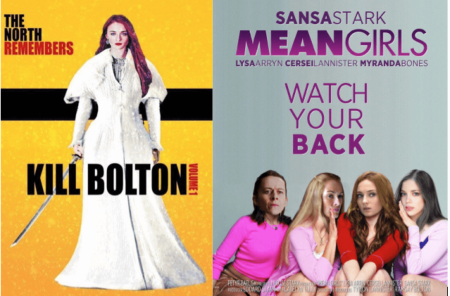
Since its debut in 2010, HBO’s Game of Thrones has attracted a significant amount of criticism and celebration. Pivoting on the series’ frank and brutal representation of sex and violence, as well as sexual violence, many critics have charged the programme as morally reprehensible, categorically anti-feminist and ‘bad for women’. On the other hand, however, the series has also been viewed as actively pro-feminist and, as Rhiannon Evans puts it, ‘the most complex and diverse cast of female characters on the screen’, thus demonstrating that Game of Thrones is neither an ideological container for misogyny that can be simply ‘read off’ the text, nor is it necessarily a feminist flag-waver. Put simply, Game of Thrones has been read as both exploitative and emancipatory, pro- and anti-feminist, a dialectical dance between different poles, political position-takings, and portfolios of interpretation. As Toril Moi states (1986: 220), ‘there is not, unfortunately, such a thing as an intrinsically feminist text’, which would also suggest the obverse: that there is no such thing as an intrinsically anti-feminist text either. It would seem that some scholars have forgotten that ‘popular culture does not produce either purely dominant or purely oppositional meanings but is instead a site of contradiction where meanings are continually contested and negotiated’ (Read, 2000: 13).
Asking whether or not Game of Thrones falls neatly and unproblematically into either ideological camp is perhaps the wrong question, especially given that audiences tend to use and evaluate cultural items in a wide variety of different ways (as several decades of audience studies has surely taught us by now). Indeed, perhaps it would be more productive to ‘ask audiences’ directly, a challenge taken on by Martin Barker, Clarissa Smith and I when we launched a large-scale online questionnaire in early 2016. (The questionnaire is still active and will remain so until the end of the current season, so please head over to questeros.org if you haven’t already done so.)
In 2015, the episode ‘Unbowed, Unbent, Unbroken’, which ended with Ramsay Bolton raping his new bride, Sansa Stark, was singled out for general opprobrium in press discourse (professional, amateur and pro-am). In an earlier piece for CST Online, I argued that many cultural commentators – from bloggers to journalists – took to the internet to condemn the scene, and, in some cases, to advertise liberal credentials by boycotting the show entirely. Popular feminism blog, The Mary Sue, for instance, raged against the scene and publically declared that ‘we will no longer actively be promoting Game of Thrones […] rape is not a necessary plot device’ (The Mary Sue has since reneged on their blanket ban following claims that season 6 was one of ‘the most feminist seasons ever’).
![Popular feminism blog, The Mary Sue, for instance, raged against the scene and publically declared that ‘we will no longer actively be promoting Game of Thrones […] rape is not a necessary plot device’ Popular feminism blog, The Mary Sue, for instance, raged against the scene and publically declared that ‘we will no longer actively be promoting Game of Thrones […] rape is not a necessary plot device’](https://cstonline.net/wp-content/uploads/2017/08/IMAGE-2-450x324.png) Writing for The Guardian, Sarah Hughes fretted about the potential impact on viewers by asking, ‘how much more can audiences take?’ Of course, this kind of thinking constructs what Martin Barker terms ‘figures of the audience’ — that is to say, it is an imputation largely based on the writer’s own anxieties and insecurities about media ‘effects’, as opposed to empirical evidence. Indeed, one of the key factors in press discourse, be it professional or blog-oriented, is that condemnation solely rests upon such imputations. Given that the recent season opener, ‘Dragonstone’, attracted 25.7 million viewers across delivery platforms and shattered HBO records, and that such ratings have climbed each and every consecutive season since the series debuted in 2010, I am certain that audiences are fine — else, one could surely ask: why would they continue watching if they are being pummelled and brutalised by the violence therein?
Writing for The Guardian, Sarah Hughes fretted about the potential impact on viewers by asking, ‘how much more can audiences take?’ Of course, this kind of thinking constructs what Martin Barker terms ‘figures of the audience’ — that is to say, it is an imputation largely based on the writer’s own anxieties and insecurities about media ‘effects’, as opposed to empirical evidence. Indeed, one of the key factors in press discourse, be it professional or blog-oriented, is that condemnation solely rests upon such imputations. Given that the recent season opener, ‘Dragonstone’, attracted 25.7 million viewers across delivery platforms and shattered HBO records, and that such ratings have climbed each and every consecutive season since the series debuted in 2010, I am certain that audiences are fine — else, one could surely ask: why would they continue watching if they are being pummelled and brutalised by the violence therein?
In the penultimate episode of season six, ‘The Battle of the Bastards’, Sansa Stark does indeed have her day and enacts her vengeance not with swords or sorcery, but by turning Ramsay Bolton’s own vicious hounds against him. As Sansa walks away from this dog’s dinner, she smiles to herself, satisfied that her assailant has finally received the comeuppance he deserves, while the soundtrack of Bolton’s screams provide catharsis for both character and audience (as demonstrated by a flurry of online memes and discourses which I shall return to shortly).
I have been thinking for some time that Sansa’s narrative arc shares common principles with rape-revenge films, which are ‘often considered the lowest depth to which cinema can plummet, catering to a demented demographic’ (Heller-Nicolas, 2011) — and that shifting the (reactionary and conservative) lens by which Game of Thrones is often judged in press and, to a lesser degree, academic discourse, provides an interesting counter-point that is worth exploring further. Indeed, it is quite remarkable that Sansa’s narrative trajectory has been vilified in similar ways to perhaps the most hated and debated rape-revenge film in history, the exploitation classic, I Spit on Your Grave (1978), a so-called ‘video nasty’ that was famously and vehemently lambasted by critics such as Roger Ebert, who signalled that the film was nothing but reprehensible, ‘a vile bag of garbage’ that ‘makes rapists of us all’ (see Clover, 1992: 228-29); or his partner-in- protest, Gene Siskel, who neatly rejects the film as anti-feminist, ‘a cruel film that expands upon the notion that women are nothing but sexual playthings’ (see Starr, 1984). But the thing that bothers Ebert and Siskel most is not the film’s content per se, but that it is sadly lacking in craftsmanship (‘it is made artlessly’), thus reproducing stale cultural distinctions between cinematic ‘art’, on the one hand, and the dirt and filth of the grindhouse (read: trash), on the other.
However, since the film’s release in theatres and on video rental shelves, the film has gone through a kind of academic rehabilitation since as early as 1984 in Marco Starr’s insightful, ‘J. Hills is alive: a defence of I Spit on Your Grave’, collected in Martin Barker’s (sadly out-of-print) critical anthology, The Video Nasties: Freedom and Censorship in the Media (1984). As with Stieg Larsson’s Nordic book-buster, The Girl with the Dragon Tattoo — which was originally titled The Men Who Hate Women before its politicised neutering at the hands of marketing executives — I Spit on Your Grave is perhaps best understood via its ‘proper’ title, Day of the Woman, a paratextual shifting that re-focalises the thematic thrust of the film. As Marco Starr put it, the film depicts violent aggression and hatred towards women while simultaneously condemning those very attitudes…To argue that I Spit on Your Grave is a dangerously sexist threat towards women simply because it features simulated sexual brutality, is to be unwilling or unable to recognise the importance of [Meir Zachi’s] own attitudes towards his characters. If anything, it is the men who are actually being warned to get back in line. The rapists’ continuing refusal to recognise Jennifer’s rights as a human being make them seem monstrously inhuman; their ultimate deaths can only be viewed as inevitable (Starr, 1984: 52).
Addressing the notion that I Spit on Your Grave might well be ‘a radical feminist text’, Carol Clover claims that ‘feminist critics hate themselves more for having seen Dirty Harry or Rambo: First Blood Part 2 or the rape-murder in Hitchcock’s Frenzy’ (1992: 115). One male viewer in Clover’s study found the film to be ‘such a devastating commentary on male rape fantasies and also on the way male group dynamics engender violence that he thought it should be compulsory for high school boys’ (115 – 116). Likewise, in Kate Egan’s excellent Trash or Treasure?: Censorship and the Changing Meanings of the Video Nasties (2012), two feminist viewers provide opposing viewpoints that dovetail with this to-and-fro between ideological readings, as with Game of Thrones. For Cherry, the film is nothing but ‘misogynist and tasteless’, a comment that Ebert and Siskel would surely find to their liking, whereas Andrea believes that ‘it’s a feminist work’ (2007: 146). More recently, The Guardian’s Julie Bindel revisited and revised her own thoughts about I Spit on Your Grave by headlining that ‘she was wrong’ about the film despite being actively involved in pickets and protests during the early 1980s when ‘video nasties’ were being screened in cinemas, ‘the worst of which, we feminists argued, was I Spit on Your Grave’. Bindel claims that The Accused, starring Jodie Foster and Kelly McGinnis, is more offensive despite its canonical status as a feminist film, because it is a utopian fantasy, ‘a fairy tale about how we would like things to be, but had failed to make happen during the glory days of the film’s movement’. Bindel ends by claiming that the realism and brutality of I Spit provides more comfort and catharsis for women than The Accused.
In 2010, I Spit on Your Grave became the latest in a long line of cult classics to be given the remake treatment. Steven Monroe’s reinterpretation is certainly a more gruesome affair than Zachi’s original, with a rampant orgy of violent vengeance and phallic destruction most commonly associated with the so-called ‘torture porn’ cycle sparked off by Saw, and its welter of sequels, Hostel and so forth (see Jones, 2014). Laura Mee (2013) addresses the shifting politics between Zachi’s original and Monroe’s remake – which was also followed by two sequels, one of which includes a scene where Jennifer Hill begins to fellate someone in a back alley before biting off his cock in gory detail – by claiming that the new version ‘actively enhances the perceived feminist message of the original’. As with critics of Game of Thrones, however, Mee isolates a ‘message’ contained within the film, which the academic ‘expert’ is trained to unveil and ideologically decode unproblematically and, thus, leaves no space for negotiation, interpretation and evaluation by audiences. Films, and other cultural materials, are not simply ‘message-vehicles’ to be either celebrated or denounced once an authoritative body has completed expert evaluation and ideological surgery. Although this post does not pretend to be as academically rigorous as a ‘proper’ study, identifying discursive clusters and divergent patterns that clash in conflict and contradiction, must surely question the validity of making claims about ‘messages’ and such – for what kind of message system must it be if audiences and academics disagree, often quite vehemently, about what this or that film, TV series, etcetera, ‘means’. Clover’s psychoanalytic parlour tricks aside, I agree that this should not be seen as ‘an effort to arrive at the real politics of I Spit on Your Grave, but to suggest that pinning down politics can be a tricky business even in the most seemingly transparent of cases, and that the politics of horror and in this particular film are less than self-evident’ (116).
And so it is with Game of Thrones.
The category ‘rape revenge’ does not constitute a discrete genre, for what kind of genre would permit such divergent fare as, say, Austin Chick’s Girls Against Boys (2012), Ingmar Bergman’s The Virgin Spring (1960), Peter Strickland’s Katalin Varga (2009), or Gasper Noe’s Irreversible (2002). Instead, ‘rape-revenge’ should be better viewed as a ‘narrative structure which has been mapped over other genres’, as Jacinda Read puts it (2000: 25). In this way, mapping rape-revenge onto Game of Thrones — or, more accurately, onto Sansa Stark’s serial arc — is less about generic affiliation than a narrative structure that cuts across genres.
How, then, was Sansa’s canine vengeance framed in reception discourse? To return to The Guardian’s Sarah Hughes, who queried whether season five had been too brutal to enjoy, Game of Thrones ‘serves up TV’s finest hour’ with ‘The Battle of the Bastards’, surely one of the most gruesome and gory episodes in the series thus far (although ‘The Red Wedding’ takes some beating as far as volume of gushing claret). On this occasion, however, Hughes describes the episode as a ‘weirdly cathartic hour’. Likewise, The Atlantic’s Megan Garber framed the death of Ramsay in cathected terms (‘a satisfying mix of karmic justice and audience catharsis’) as did Glamour’s Mike Laskasky (‘the most cathartic death in Game of Thrones history’), and First Post’s Vishnupriya Bhandaram (‘vengeful, bloody, gory and most of all cathartic’). On Bustle, Martha Soren expressed gratitude (‘thank you Sansa for giving us this magical day’) while Ben Travis of The Evening Standard said that ‘the show’s major human villain got his demise – having his teeth knocked in, and being eaten by his own ravenous hounds. People were pleased, to say the least’.
Indeed, in the minutes and hours after the episode, audiences turned to the affordances of social media to celebrate Ramsay’s death and, more pointedly, to cheer Sansa’s retributive justice:
- ‘Watching Ramsay get eaten by his own dogs was so therapeutic’.
- ‘Did anyone else cheer aloud when Ramsay got eaten by his own dogs?’
- ‘For those who waited for Sansa to make good, there you go’.
- ‘Ramsay’s going to the dogs. And Sansa, you are my goddess’.
- ‘Watching Ramsay Bolton get eaten by dogs was the most satisfying thing I’ve ever seen’.
As usual in contemporary time, parodic memes were generated and circulated, such as Ramsay’s face branding dog food or Sansa sitting happily on the Iron Throne as the new ruler of a Matriarchal Westeros. T-Shirts were rushed into production decorated with Sansa’s face atop the words, ‘Who Let the Dogs Out?’, a commonly adopted intertextual riff on the Baha Men’s early millennium smash hit single that features in multiple memes and news stories, as well as, surprisingly, a set of license plates.
.

Even in such a cursory, and admittedly ‘cherry-picked’, sample, it is not too much of a wild leap to suggest that ‘rape is a more taboo and emotionally volatile crime to portray on-screen than murder’, as Jason Mittell argues in another context, and that fictional homicide is not only widely embraced, but commended and lionized. But the point here is that if rape-revenge ‘provides its spectators with a cathartic sense of justice through retributive violence’ (Henry, 2015: 1), then it stands to reason that Game of Thrones may well do the same, especially if the discursive motif of catharsis, celebration and triumph are factored into the debate, as well as the stone-cold fact that the violence in Game of Thrones is rather vanilla compared to I Spit on Your Grave — that is to say, the former is hardly transgressive (not even subversive perhaps). Incidentally, the Amazon Prime series, Outlander, includes representations of male and female rape much more graphic than anything in Game of Thrones, but has received hardly any criticism. Indeed, it is interesting which texts get singled out for criticism and which get left alone, such as the way in which Fifty Shades of Grey sparked moral outrage whereas Lars Von Trier’s Nymphomaniac – again, much more explicit than Game of Thrones – is given little attention by press discourse. (Perhaps this has more to do with cultural distinctions between ‘high’ art and low, pop culture than anything else.)
I am not interested at all in moral position-takings and I am not about to lay into critics who are appalled at representations of rape, but then hypocritically cheer cold-blooded murder – after all, my main point has always been that representing rape is not the equivalent of promoting rape and that ‘there is more going on here’ than reductive and simplistic ‘ideology-by-numbers would permit. Indeed, if watching rape in fictional contexts ‘makes rapists of us all’, then surely that logic would mean that jubilantly dancing on the (fictional) corpse of Ramsay Bolton ‘makes murderers’ out of us all, equally. (Following recent episode, ‘The Loot Train Attack’, many online users roared approval as Daenery’s dragon burned hundreds of soldiers to a crisp.)
Viewing Sansa’s story as a rape-revenge narrative is evidently far more complicated and complex, especially when adjoined to the academic work around rape-revenge films, work that reveals a substantial gap that is yet to be sufficiently exploited by audience researchers. Although Barker et al’s commissioned research for the BBFC on audience responses to sexual violence in cinema is a step in the right direction, there has yet to be a sustained audience study of the rape-revenge film, at least as far as I am aware. Asking whether or not I Spit on Your Grave, Wes Craven’s Last House on the Left, Abel Ferrara’s Ms. 45, Quentin Tarantino’s Kill Bill, or indeed Game of Thrones, is steadfastly feminist, or, resolutely anti-feminist is fraught with difficulty, conflict and a welter of imputation. Cultural items are so much more fascinating once we move beyond constituting ideological binaries without moving beyond ‘the text’ itself or to recognise that audiences usually see things rather differently.
I am always fascinated – and sometime irked, if I’m being reflexive – by the way in which representations have the power to attract huge sweeping generalisations based largely on the critics’ own politics, fears and anxieties, as well as the oceans of empathy generated towards fictional characters. Indeed, more ink and tears have been spilled over representations of rape than actual rape, as Barbara Ellen rightly argued in The Guardian. Less has been said about Tory minister, Peter Cuthbertson, who believes that a woman’s ‘promiscuity’ should be considered a leading factor in real rape cases as those with ‘low morals’ are more likely to lie and deceive (although Theresa May defended him by claiming he has ‘made clear that his views have changed’); and even less about Scottish MP Michelle Thompson’s devastating account of her own rape at the age of fourteen bravely told publically in the commons. So, while calls for Craig Revel Horwood’s sacking after his admittedly poorly phrased remarks about ‘liking the rape scenes’ in Game of Thrones attracted the venom of fans and tabloid journalists and dominated press discourse – although nobody seemed to be particularly bothered about his enjoyment of violence per se (‘I liked the cleavers through the skulls’) – it certainly seems that something is off, that there is a gross imbalance between fictional and actual rape. That many rape survivors find comfort and catharsis in representation should no longer be disavowed in favour of knee-jerk moralising, as The Telegraph’s Eleanor Muffitt’s (cathected) argument emphasises (‘Game of Thrones has finally given us survivors the rape scenes we so desperately needed to see’). I am not implying that everyone who has been raped will no doubt find catharsis at HBO, only that the democracy of interpretation should be recognised as such and, moreover, it would seem especially cruel to call for censorship when so many people deal with the politics of representation in a wide variety of different ways. Claiming that Game of Thrones is only ‘bad for women’ doesn’t account for those who find it ‘good for them’ (although I am aware that framing it in these terms may be contentious). Perhaps audiences feel more empathy for characters such as Sansa Stark primarily because they have spent at least some time ‘getting to know her’, regardless of whether or not she exists (she doesn’t). Perhaps our Game of Thrones audience project may provide further interventions into this contentious arena, but we shall have to wait and see. Clearly, there is a lot more work to be done.
Dr. William Proctor is Lecturer in Media Culture and Communication at Bournemouth University, UK. He is currently writing his debut monograph, Reboot Culture: Comics, Film, Transmedia, to be published by Palgrave Macmillan in 2018. William has published on a variety of topics linked to popular culture, such as Star Wars, The Walking Dead, Remake/ Reboots, Fan Cultures and Batman. He is the Director of the World Star Wars Project; co-director of the Transmedia Earth Project (with Matthew Freeman) and one of three key investigators on the Game of Thrones audience project (with Martin Barker and Clarissa Smith).



